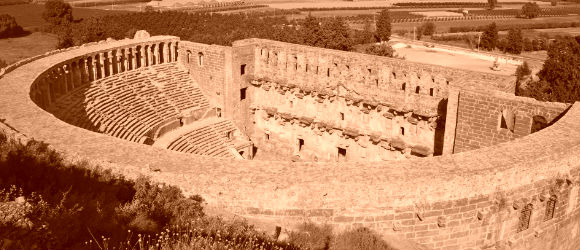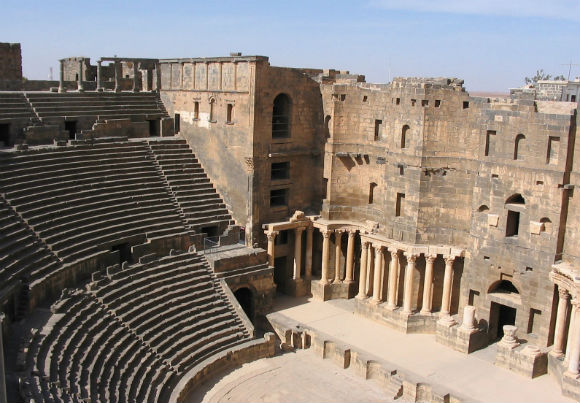Aspendos was an ancient Greco-Roman city in Antalya province of Turkey. It is located 7 kilometres (4.3 mi) northeast of central Serik.
Aspendos was an ancient city in Pamphylia, Asia Minor, located about 40 km east of the modern city of Antalya, Turkey. It was situated on the Eurymedon River about 16 km inland from the Mediterranean Sea; it shared a border with, and was hostile to, Side. According to later tradition, the (originally non-Greek) city was founded around 1000 BC by Greeks who may have come from Argos. The wide range of its coinage throughout the ancient world indicates that, in the 5th century BC, Aspendos had become the most important city in Pamphylia. At that time the Eurymedon River was navigable as far as Aspendos, and the city derived great wealth from a trade in salt, oil, and wool.
Aspendos did not play an important role in antiquity as a political force. Its political history during the colonization period corresponded to the currents of the Pamphylian region. Within this trend, after the colonial period, it remained for a time under Lycian hegemony. In 546 B.C. it came under Persian domination. The face that the city continued to mint coins in its own name, however, indicates that it had a great deal of freedom even under the Persians.
In 467 B.C. the statesman and military commander Cimon, and his fleet of 200 ships, destroyed the Persian navy based at the mouth of the river Eurymedon in a surprise attack. In order to crush to Persian land forces, he tricked the Persians by sending his best fighters to shore wearing the garments of the hostages he had seized earlier. When they saw these men, the Persians thought that they were compatriots freed by the enemy and arranged festivities in celebration. Taking advantage of this, Cimon landed and annihilated the Persians. Aspendos then became a member of the Attic-Delos Maritime league.
The Persians captured the city again in 411 B.C. and used it as a base. In 389 B.C. the commander of Athens, in an effort to regain some of the prestige that city had lost in the Peloponnesian Wars, anchored off the coast of Aspendos in an effort to secure its surrender. Hoping to avoid a new war, the people of Aspendos collected money among themselves and gave it to the commander, entreating him to retreat without causing any damage. Even though he took the money, he had his men trample all the crops in the fields. Enraged, the Aspendians stabbed and killed the Athenian commander in his tent.
When Alexander the Great marched into Aspendos in 333 B.C. after capturing Perge, the citizens sent envoys to him to request that he would not establish that he be given the taxes and horses that they had formerly paid as tribute to the Persian king. After reaching this agreement. Alexander went to Side, leaving a garrison there on the city’s surrender. Going back through Sillyon, he learned that the Aspendians had failed to ratify the agreement their envoys had proposed and were preparing to defend themselves. Alexander marched to the city immediately. When they saw Alexander returning with his troops, the Aspendians, who had retreated to their acropolis, again sent envoys to sue for peace. This time, however, they had to agree to very harsh terms; a Macedonian garrison would remain in the city and 100 gold talents as well as 4.000 horses would be given in tax annually.
In 190 BC the city surrendered to the Romans, who later pillaged it of its artistic treasures. Toward the end of the Roman period the city began a decline that continued throughout Byzantine times.
Aspendos,



I have mixed feelings about this site. While this is a quick and easy place to get to and it is easily accessible for everyone to visit the theatre because there is not much walking at all involved from the parking to the theatre, I think it is too expensive compared to other ruins. There is really nothing much else…
lunch is basic, the ruins have been rebuilt since the first world war and they are still not half up but very nice if you like seeing these things
Each June the International Opera and Ballet Festival at Aspendos is held and we got tickets for the opening night performance of Aida by the Ankara State Opera and Ballet from a booth outside the Side Museum..
Nice to be able to enter the amphitheatre and get a good look round. Went part of a Thomas Cook day tour and tour guide was brilliant
Amazing place, well worth a diversion to see it – would love to go back when concerts/opera are held in the Summer.
Extremely well preserved and amazing to think its nearly 2000 years old.
It's a shame that not very many tourists visiting Antalya make the trip to see this extremely well preserved ancient Roman theatre. When I took my boyfriend and his family there, I think they were ecpecting a small ruin that hasn't stayed intact and they were really amazed. And in the words of my boyfriend's brother, who is rarely impressed…
This is an amazingly preserved structure, totally breathtaking in all it's glory, probally the best I have ever seen, the fact that you can walk the paths of the Romans underneath the theatre is just a wonderfully erie experience, it gives a very true feel to the experience, seeing the pictures of the backdrop of the theatre is spectacular, there…
Aspendos is a great site to visit by day as you can witness one of the best preserved amphitheatres in the world. However, to really get the best out of the place take advantage of the opportunity to attend the opera and ballet festival in June and September. Seeing top class performances is great in itself, but in the setting…
We visited Aspendos theatre, the acquaduct and the bridge which were all very impressive! If you are into roman history, a trip to Aspendos is definitely a must! You can also spot a lot of turtles in the area!
We came by public bus from Side – first we took the dolmuş to Manavgat and from there the bus to…
A place you really have to visit when you are in the area. But not between 12.00-15.00 the hottest hours of the day…bring water with you and clothing (cotton) and good shoes to walk.